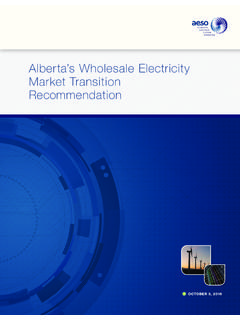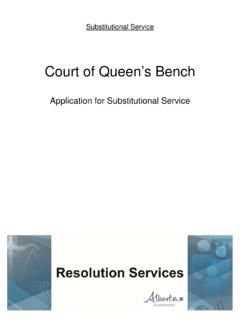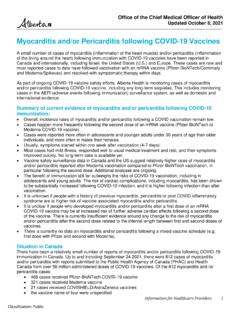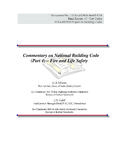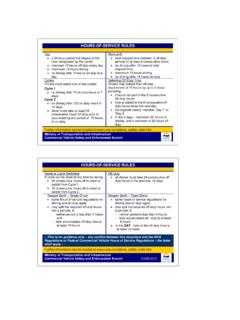Transcription of NATIONAL SAFETY CODE SAMPLE SAFETY AND …
1 NATIONAL SAFETY code SAMPLE SAFETY AND MAINTENANCE PROGRAM Provincial Trucks, Truck-Tractors, and Trailers Last Revised: December, 2016 Alberta Transportation 12/2016 Page 1 of 34 NOTICE TO READERS This document has been prepared by the Carrier Services Section of Alberta Transportation. It includes SAMPLE SAFETY and maintenance programs for provincial carriers that operate trucks, truck-tractors, and/or trailers. Provincial carriers operate commercial vehicles registered for a weight of 11,794 kilograms or more solely in Alberta. What are SAFETY and Maintenance Programs? SAFETY and maintenance programs are written documents that provide SAFETY and maintenance expectations for all employees within a company.
2 All NATIONAL SAFETY code (NSC) carriers are required by law to have these programs in place. The SAFETY program allows carrier SAFETY management to ensure all authorized drivers have sufficient training and qualifications to safely operate the company s commercial vehicles. The maintenance program helps management confirm that all vehicles owned by the company are properly maintained before they are operated on highways. For more information about the purpose of SAFETY and maintenance programs, refer to Modules 5-6 of the Commercial Vehicle SAFETY Compliance in Alberta education manual. Using these SAMPLE SAFETY and Maintenance Programs This document MUST be altered to address the compliance and operational needs of a specific carrier.
3 This SAMPLE document, by itself, should not be used or accepted as meeting a carrier s regulatory requirement unless it has been appropriately modified and implemented. Carriers that use these SAMPLE programs to meet regulatory requirements must go through the document and fill in the missing fields. Any attempt to submit the document without the completed fields will result in an error message when the Submit or Print button is clicked on the last page. Carriers that wish to include more policies that are specific to their operations may use these samples as a guideline for ensuring they meet minimum regulatory requirements.
4 Every effort has been made to ensure that the information in this document is accurate at the time of preparation. However, this document is intended to serve only as a guide and cannot replace first-hand information such as specific legislation. The items included in this document are considered to be the minimum items required by law. Carriers may include additional policies to these minimum requirements in their programs. It is the carrier s responsibility to ensure that SAFETY and maintenance programs meet all regulatory requirements. Corrections, comments and suggestions for this document can be submitted to Alberta Transportation at any time by contacting Carrier Services Section at 403-755-6111 (toll free in Alberta by first dialing 310-0000) or by email to To assist you in meeting the minimum requirements, the following website may help when developing your programs and/or training.
5 You are required to implement your SAFETY and maintenance program, evaluate it 12/2016 Page 2 of 34periodically and update it as necessary. For more information on SAFETY and maintenance programs and training, view our education manual online at: For more information on Regulatory Requirements consult the following legislation: Commercial Vehicle Certificate and Insurance Regulation (AR 314/2002); Commercial Vehicle SAFETY Regulation (AR 121/2009); Vehicle Inspection Regulation (AR 211/2006); Vehicle Equipment Regulation (AR 122/2009); and Traffic SAFETY regulations are available from the Queens Printer at 780-427-4952 or online at: 12/2016 Page 3 of 34 SAFETY PROGRAM FOR COMMERCIAL TRANSPORTATION Provincial Trucks, Truck-Tractors, and Trailers Name on SAFETY Fitness Certificate: Prepared By: 12/2016 Page 4 of 34 AUTHORIZED DRIVERS Authorized drivers include all employees that are permitted to operate NATIONAL SAFETY code vehicles registered to _____.
6 Authorized drivers include: Company Name managers/owners who drive; part-time or occasional drivers; company mechanics who test drive vehicles or drive part-time; SAFETY staff who train drivers; lease operators who have their vehicles registered to the company; contractors who have their vehicles registered to the company; anyone else authorized to operate a company authorized drivers must follow the policies and procedures found in this SAFETY program. By following the policies in this program, all authorized drivers will be more aware of how to operate safely and to prevent collisions.
7 12/2016 Page 5 of 34 PART 1: SAFE USE AND OPERATION OF VEHICLES _____ will ensure all drivers are aware of the safe use and operation of commercial Company Namevehicles. Drivers must comply with all transportation SAFETY laws, including those related to: Speed Limits Drivers must obey all posted speed limits and reduce speed according to road, weather, visibility conditions and vehicle type. Seat Belt Use All authorized drivers, while operating or travelling as a passenger in company vehicles, must wear seat belt(s) at all times. Drug and Alcohol Use The possession and/or consumption of alcohol, illegal drugs, or the misuse of prescription drugs are strictly prohibited while drivers operate company vehicles and other equipment.
8 Defensive Driving Authorized drivers must operate company vehicles in a professional and courteous manner. Drivers must be prepared to avoid collision causing situations by practicing and by promoting the principles of defensive driving. For example, drivers must be aware of their surroundings and look ahead. Drivers should leave a safe distance between vehicles, keep the vehicle under control at all times and be prepared for changes in road, weather and traffic conditions. Distracted Driving As part of practicing the principles of defensive driving, authorized drivers must remain focused and follow all distracted driving laws.
9 The following activities conducted while driving are considered distracted driving: using hand-held cell phones; texting or emailing (even when stopped at red lights); using electronic devices like laptop computers, video games, cameras, video entertainment displays, andprogramming portable audio players ( MP3 players); entering information on GPS units; reading printed materials in the vehicle; writing, printing or sketching; and personal grooming (brushing teeth, putting on makeup, clipping nails, shaving, etc.).12/2016 Page 6 of 34 Cargo Securement The carrier and driver must ensure that all any cargo transported is contained, immobilized or secured in according to NATIONAL SAFETY code Standard 10.
10 The following are some general guidelines for ensuring cargo is secured in a safe manner. Generally, cargo transported on a commercial vehicle must not: leak, spill, blow off, fall from, fall through or otherwise dislodge from the commercial vehicle; or shift upon or within the commercial vehicle to such an extent that the commercial vehicle s stabilityor maneuverability is adversely must inspect the cargo and its securing devices within the first 80 kilometres after beginning a trip. Drivers must re-inspect cargo when any one of the following occurs: change of duty status ( from driving" to on-duty not driving ); after driving for 3 hours; or after driving 240 employee or driver will not use any vehicle to transport goods unless.


